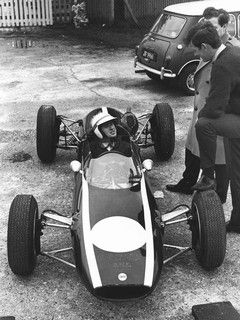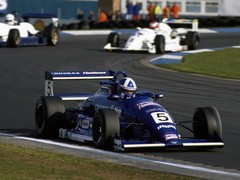Motorsport on Monday: the demise of British F3
...and why it's very much a bad thing despite a recent resurgence

OK... but Jim Clark, Jackie Stewart, Nelson Piquet, Ayrton Senna and Mika Hakkinen's names are but just a few on the trophy, with the likes of Lewis Hamilton and Daniel Ricciardo more recent graduates of the series.
With most of the teams on the F1 grid based in Motorsport valley, the British series has always acted as a great cauldron in which to prove yourself as a young single-seater driver looking to progress to the next level.
But with more championships and promoters looking to get fat on a slice of the action in recent times, it's proved a nasty infection for British F3, and one that it's only just starting to shake.
Round cull
Back at the start of 2013, it was announced that the championship was being cut from 10 rounds to just four triple-header events, of which only two would actually take place in the UK. This on top of dwindling grids cut in half compared to those in the early 2000s.
Silverstone and Brands joined Spa and the Nurburgring on the calendar, with the European rounds included to help boost grids through a crossover with F3 on the continent.
So while the German national championship and the Europe-wide series looked strong, British F3 took a bit of a pasting when it came to numbers - and that was the best it could have hoped for, acting relatively quickly to actually secure some rounds to put a calendar together. Any more dallying and the championship would have gone to the wall just like Formula Renault UK.
Berger me
Getting the traditional F1 stepping stone back on track is a difficult job for the FIA's single-seater commission president, Gerhard Berger, but one he knows must be tackled to set the sport straight. But what are the problems that need to be ironed out?
Regulations, for a start. F3 should be a constant across the globe, so drivers from all territories can be judged equally and fairly in similar machinery. However, in the recent past, differing regulations for differing national and international F3 titles have meant it wasn't entirely clear who was racing to what rules, blurring any lines of comparison.
This also creates a problem for teams in the form of budget, Money makes the motorsport world go round, and with around £400,000 per year minimum needed to make your British F3 world revolve, it's not exactly a cheap business. Which leads to sponsors.
If there are too many splintered F3 championships running to different rules, TV audiences are more than likely going to be lower than if the setup featured a few core F3 series. The potential ROI doesn't exactly encourage sponsorship, which is unsustainable. And we're back to square one.
Formula Resurgence
Some will argue there are still too many junior formulae around, with a multitude of F3 championships around the world, F4 and GP3 all vying for similar ground. However, Berger's plans to knock heads together in Formula 3 from the moment he started at the FIA seems to have got the British championship back on track. Even if it's not in the way he intended.
For this year the new era of bespoke racing engines used in FIA European F3 (the series Berger brought in to try and level the playing field) wasn't adopted in the British championship on cost grounds, with teams able to use the older, cheaper production-based motors and electronics in a bid to boost numbers.
A similar thing has happened with aero for the same reasons, with British F3 organisers banning the use of barge boards, bridge front wings and aero parts in front of the rear wheel of the older, faster Dallara F308 chassis and Mygales of a similar age in a bid to balance pace out against the newer F312 chassis.
Making things equal and cutting costs needed to run a full season seems to have worked initially. More team support coupled with the realisation by series promoter SRO that the British F3 championship needs to be run mostly in Britain means we have seven of the eight rounds on home soil.
FIA forcing the hand
However, what will happen next year is still uncertain. Could 2014 be a resurgent blip in the continuing demise of British F3? I hope not when the series has such a rich history and has managed to pick itself up off the floor.
Engine and chassis regs will be key to keep a lid on costs, as will the FIA's willingness to get involved. Or not as the case may be.
With British F3 not keen to adopt the new power unit rules for this year, the FIA expressed its "surprise" at the use of the F3 tag, as the championship didn't actually conform to its rulebook.
The wrangling looks set to continue long into the future, which is a shame, because British F3 deserves to have a bright future, just like its past.
[Images: LAT]
Happy days!
back 15 years ago I feel it had a clear purpose, now I think its a series which is competing against other series, and when your young you hardly want to spend an extra year, and an extra years cash, going through an irrelevant forumla
Happy days!
It was Pike, Nunn ...and the late great Bev Bond (who drove for Ginetta before Chapman nicked him).
Talking of Ginetta and F3, here's a bit of useless info that even some F3 followers don't know. A Formula 3 race on the 30 Aug 1964 at Snetterton saw the debut of the monocoque chassis Ginetta G8.
It lined up on the front of the 16 car grid with Chris Meek at the wheel of Ginetta's new single seater (it even had its wheels painted yellow like the Lotis!), alongside a Brabham BT9, a couple of Lotus 31s, a Brabham BT9 (driven by someone who went on to become a F1 boss by the name of F. Williams).
Rodney Banting's Loti 31 won, another 31 came second, Frank's BT9 was third and the Ginetta came fourth.
Even with a 7 car grid they've still managed to knock each other off...
Someone commented that Formula Ford has moved on? It hasn't - it still exists in it's original form and provides great club racing. IMHO, if a young man can't get a minimum wage job, spend every penny and not be able to do a full season then the system is broken. The options are F4 and the 'new' FF, but they still fall very short on value for money and affordability. Karting has been going a similar way now for years, and the recent dramatic drop in license numbers demonstrates this (now <3000).
Takuma Sato was mega through dingle dell, riding the kerbs to perfection and launching the car into the air. Gained about half a second per lap every time. Been a fan ever since.
The first event I marshalled was the 1970 Croft F3 meeting - 66 entries, two heats and a final ; manic racing and drivers such as Hunt and Pace. The 1 litre screamer series was sublime with exquisite looking cars from many different chassis and a fabulous noise .Check these cars out now in HSCC F3.
Unlike many I never regarded the subsequent 1.6 and 2 litre F3 as especially notable - at least not until the mid 90s. The drivers were there - Senna , Piquet ,Mansell,Sullivan ,Nilsson Brundle , Wallace and Donnelly and the rest - but the races were often dull and the cars sounded flat as a fart with a tiny powerband. But things got much better and the sight - and sound - of a full grid blasting away from the grid at Oulton was something special. Last time I saw F3 there an Aussie called Ricciardo starred- the boy done good ..
The highlight of many years watching F3 was Takuma Sato getting pole at Croft in about 2002; the car(the inevitable Dallara) looked and sounded the business and never have I seen anybody wring the neck of a car so thoroughly. The lap record he set when he won the race stood for years .The best drive- Gunnar Nilsson at Cadwell in 1975(?) - utterly in command and a lovely man. (I remember him crashing at Silverstone in front of me , extricating himself from the wreck and ambling over with a sheepish grin to cadge a Marlboro)
I saw Formula Ford Ecoboost at Croft the other week and could have wept. Thin grid,average racing and cars that sounded dreadful
Bring back F3 as it should be - and was- and I will be very happy
other issues include the cost of F1. the more expensive that is, the more expensive the ladder under it becomes. However the biggest issue is Bernie and CVC. Sucking so much finance out of the sport that it impacts at all levels. Your race entry fees are high as a direct result of the cost of staging a grand prix.
Back to F3, the cars need to be more powerful, nearer 300 brake would be more relevant, when you consider the next step up has around 600hp. Currently I think they have 220hp?
Other points raised on this thread about the MSA's competence is also relevant, British rallying is knackered and the closed road bill may be it's saviour. Overall too many mini Bernie's take too much money from our sport. All these championships should be run by the MSA, with any profits put back into the sport. They (the msa) are just not entrepreneurial enough.
Engines were made by Mercedes, VW, FIAT, Mugen Honda, Renault and Opel amongst others. A national class engine is approx £ 20,000 plus electronics with international class engines (more power but less mileage allowance) is more.
The new engines, with are being used in FIA F3, but not British F3 who are sticking with the old engines to reduce costs (they already exist so you don't need to buy a new engine (£ 45,000) and electronics. These are bespoke engines and the restrictor size has gone up to 28mm which will mean they will rev higher and more power can be achieved.
The new engines lap Silverstone GP circuit in 1m 51s, the best time from this years British F3 with the old engines was a 1m55 although the drivers in FIA F3 are better.
F3 has its place in the hierarchy of formulae designed to prepare up and coming drivers for Formula 1. A karting graduate would have stepped into Formula Ford to learn about racing. Lightweight cars of limited power, but also limited grip, meaning the driver has to develop a feel for the car and to learn to slide the car when necessary and to keep momentum as high as possible. Once they've done that they can move up a level to Formula Renault (slightly lesser level than F3) or an F3 series, where the cars have more power, but also have aerodynamics to learn about and after a season or two of this can make the jump up.
Jenson Button jumped straight from F3 to F1, Kimi went from Formula Renault to F1, but the others may join the GP circuit, initially in GP3 which is around 400hp, and then possibly GP2 which are 600hp.
A series like F3 has a valid place in the careers of professional single seater drivers.
Now drivers fresh from Karting say they want to jump straight into cars with aero, hence BRDC F4 and Formula Ford (soon to become FIA Formula 4) having aero, but generating nowhere near the same levels of downforce as a Formula 3 level car.
Since the top tier Formula Renault series was cancelled in 2012, a knock-on effect has been that there has been less graduates from this series into British F3. Drivers graduating from Formula Renault BARC, have often gone into Formula Renault Northern European or similar series, ultimately meaning the British series has lost out.
Edit - in the glory days when there were loads of manufactures, to become a constructor you needed some tubing, some aluminium panelling and a welder. Carbon Fibre was introduced in the mid 1980's and by the end of the decade the number of manufacturers had dropped to three or four, due to the complications and expense of making carbon fibre tubbed vehicles, and costs increased quite a bit as well. In the old days, a Formula Ford chassis could be modified to F3 spec, to Formula Atlantic spec, F2 spec quite easily.
If you took out the 26mm restrictor so it could physically ingest enough air to allow it to rev past 6500rpm, and changed the cams from ones tuned for that rev band with something higher, and remapped ignition/injection, then the resulting engine would probably be somewhere close to 340bhp.
The cost of the engine is due to the bespoke dry sump system, sump often being magnesium, the bespoke cam cover (these engines are stressed members - engine is bolted to tub, gearbox is bolted to engine, rear suspension is bolted to gearbox along with rear wing) also often magnesium, the labour cost of porting and polishing cylinder head, not just for combustion efficiency but also removing excess weight, and the same for the block, new pistons, rods and crank, throttle bodies, valves, cams and it soon adds up.
How much does Honda charge for a brand new fully dressed S2000 engine in road trim? £ 10k? Is a further £ 10k for the specific F3 bits including a fair degree of labour unreasonable?
The new engines are a different kettle of fish entirely. The regulation changes mean that everything is bespoke, so rather than starting with a Honda block and head, development cost paid for by Honda and amortised over 10,000 units a year, they are being designed, built, developed and tested in tiny numbers in comparison, so whilst the engines are lighter, more compact and more powerful, the costs are significantly higher.
It won't take long for people to do the usual -'that won't work because...' but that's just the lazy way out . If the present regs produce crap F3 then they need to be changed- there was far less money around in the F3 from the 60 s to the 80s and yet the formula was healthy . What we could do without is the daft proliferation of single seater formulae- F Renault(until recently), FPA (ditto ) , GP 3, F4 , World Series by Renault , A1 GP and the rest of the nonsense. We need one clear ladder- cheap 150bhp and no aero (a la FF1600) , basic slicks and wings with maybe 200bhp , F3 with 250-300bhp and then 'proper' F2(aka GP2 in Bernie speak ).
These engines develop sufficient torque to spin the wheels in damp condition in 1st, 2nd, 3rd and sometimes 4th gear, so whilst headline power figures are not as high as many people think, in terms of torque they are pretty punchy and even in most moderately skilled amateur hands will lap most circuits faster than a lot of more powerful cars.
The point of F3 is to prepare drivers for the next level up. It did / does this well enough. The costs grew out of control whilst there seemed to be a plentiful supply of money - testing / tyres, plus teams doing their own developments on aerodynamics / wishbones / floors / body parts (partly to reduce the cost of new (probably) Dallara parts, but to try and achieve an advantage over the rest. Then you end up with driver coaches, data experts, shiny trailers, bigger shiny trailers, personalised number plates until all the money is soaked away and more. People thought that people wanted more GP tracks or European tracks and the costs increase all the time.
We operate two F3 cars on a season budget that a professional team would spend on a weekend.
The numbers of race series, the size of grids & the complexity of the cars ebbs and flows with the amount of money that is available.
The success of each series depends on the organisers ability to adapt quickly to the changing financial situation. The comings and goings in the single seater series are echoed in the various GT series.
Gassing Station | General Motorsport | Top of Page | What's New | My Stuff











